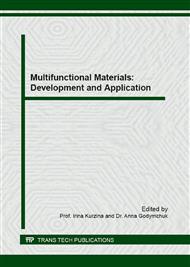[1]
S.R. Niezgoda, A.K. Kanjarla, S.R. Kalidindi, Novel microstructure quantification framework for databasing, visualization, and analysis of microstructure data, Integrating Mater. and Manufacturing Innov., 2, 3 (2013) 1-27.
DOI: 10.1186/2193-9772-2-3
Google Scholar
[2]
R.M. Axelrod, The Structure of Decision: Cognitive Maps of Political Elites, Princeton University Press, Princeton, (1976).
Google Scholar
[3]
R.G. Basaker, T.L. Saati, Finite Graphs and Networks: an Introduction with Applications, Research Analysis Corp., Mc Graw Hill Company, NY-London-Toronto, (1965).
Google Scholar
[4]
D.A. Pospelov, Cognitive graphics – a window into the new world, Software products and systems (in Russian), 2 (1992) 4-6.
Google Scholar
[5]
D.A. Pospelov, Ten hot spots, in research on artificial intelligence, Intelligent systems (MSU) (in Russian), 1 (1996) 47-56.
Google Scholar
[6]
D.A. Pospelov, L.V. Litvintseva, How to combine left and right, News of Artificial Intelligence (in Russian), 2 (1996) 66-71.
Google Scholar
[7]
А.А. Zenkin, Cognitive Computer Graphics, Nauka, Мoscow (in Russian), (1991).
Google Scholar
[8]
A.A. Zenkin, Knowledge-generating technologies of cognitive reality, News of Artificial Intelligence (in Russian), 2 (1996) 72-78.
Google Scholar
[9]
V.А. Albu, V.F. Khoroshevskiy, COGR – cognitive graphics system, design, development, application, Russian Academy of Science Bulletin, Technical Cybernetics (in Russian), 5 (1990) 12-20.
Google Scholar
[10]
A.A. Zenkin, Cognitive computer graphics, Directory of Artificial Intelligence. Book 2 Models and Methods, (in Russian), Moscow, 1990, pp.137-143.
Google Scholar
[11]
B.A. Kobrinskiy, Why should we take in account imaginary thinking and intuition in medical expert systems, Artificial Intelligence – 96, Proc. of the 5th National Conf. with Int. Participation (in Russian), 2 (1996) 207-210.
Google Scholar
[12]
A.E. Yankovskaya, Logical Tests and Means of Cognitive Graphics, LAP LAMBERT Academic Publishing (in Russian), Saarbrücken, (2011).
Google Scholar
[13]
A.E. Yankovskaya, N.M. Krivdyuk, Cognitive graphics tool based on 3-simplex for decision-making and substantiation of decisions in intelligent system, Proc. of the IASTED Int. Conf. Technology for Education and Learning, 1 (2013) 463-469.
DOI: 10.2316/p.2013.808-017
Google Scholar
[14]
A.E. Yankovskaya, A.I. Gedike, R.V. Ametov, A.M. Bleikher, IMSLOG-2002 software tool for supporting information technologies of test pattern recognition, Pattern Recognition and Image Analysis, 13 (2003) 650-657.
Google Scholar
[15]
B. Wang, X. Feng, K.H. Chu, A novel graphical procedure based on ternary diagram for minimizing refinery consumption of fresh hydrogen, J. of Cleaner Production, 37 (2012) 202-210.
DOI: 10.1016/j.jclepro.2012.07.009
Google Scholar
[16]
J. Podani, C. Ricotta, D. Schmera, A general framework for analyzing beta diversity, nestedness and related community-level phenomena based on abundance data, Ecological Complexity, 15 (2013) 52-61.
DOI: 10.1016/j.ecocom.2013.03.002
Google Scholar
[17]
A.E. Yankovskaya, Test recognizing medical expert systems with elements of cognitive graphics, Computer Chronicle (in Russian), 8 (1994) 61-83.
Google Scholar
[18]
S.V. Kondratenko, A.E. Yankovskaya, Pattern recognition system TRIANG to decision-making substantiation using cognitive graphics, Abstracts of the III Conference on Artificial Intelligence (in Russian), 1 (1992) 152-155.
Google Scholar
[19]
A.V. Yamshanov, N.M. Krivdyuk, Specify of software implementation of cognitive graphic tools in intelligent and education systems, Proc. of the Conf. Prospects of Fundamental Science Development XI, (in Russian), 1 (2014) 706-709.
Google Scholar


